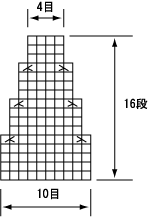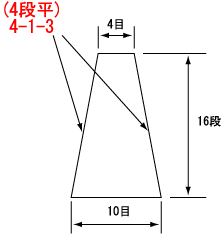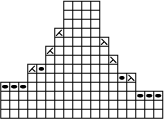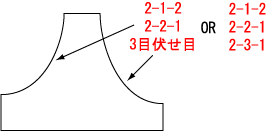| Hatched or Curved Line - Shaping On The Edge | ||
| Graphical Charts with Decreasing or Increasing on the Edge | ||
It is the basic method to shape a fabric increasing or decreasing on the edge. This means you increase or decrease at the beginning of rows or/and at the end of the rows. The chart below shows the fabric decreasing both side of the rows at the same time.
 |  |
| Detailed Chart | Simplified Chart |
You can understand the representation of a simplified chart well comparing the two charts which describe the same fabric. Especially, the notation of 4-1-3 is the most important representation which we describe here closely.
The left detailed chart makes it clear which rows must be decreased. However, the right simplified chart shows them implicitly. The notation 4-1-3 reads "Every 4th row, 1 dec(or inc), 3 times.
This notations could means several patterns which are showed below.
| (1) | (2) | (3) | (4) | (5) |
All these patterns are 4-1-3. Naturally, these patterns are close to each other. The only difference is the beginning of decreasing. Every patterns are not wrong. So you could choose anyone you're favorite. However, usually (5) are expected in Japanese patterns.
(2) and (4) are unfavorable because you have to decrease on the wrong side. Among (1)-(3)-(5), (5) makes the biggest fabric and generally bigger fabrics tend to be desirable because no margins to seam are included in the fabric's size.
The first example shows the beginning of the decreasing row might vary. And the decreasing rows of the left side and right side are the same. However, sometimes decreasing rows of each side can vary while the presented graphical patterns are the same.
 |  |
| Detailed Chart | Simplified Chart |
The above charts are for the symmetrical fabric. And both side of the simplified chart shows the same notation while the detailed chart shows the different rows of decreasing.
When you intend to decrease over two stitches at one time, it is difficult to decrease at the end of the fabric. So, you can decrease at the beginning of the row of both side instead. When you work back and forth, this method results a little bit asymmetrical fabric which is generally acceptable.
Copyright© 2001-2002 Tata&Tatao. All Rights Reserved.